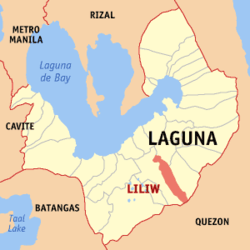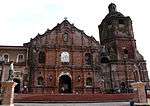Liliw
| Liliw | ||
|---|---|---|
| Municipality | ||
|
| ||
| ||
|
Nickname(s): Tsinelas Capital of the Philippines[1] / Footwear Capital of the Philippines | ||
 Map of Laguna showing the location of Liliw | ||
.svg.png) Liliw Location within the Philippines | ||
| Coordinates: 14°08′N 121°26′E / 14.13°N 121.43°ECoordinates: 14°08′N 121°26′E / 14.13°N 121.43°E | ||
| Country | Philippines | |
| Region | CALABARZON (Region IV-A) | |
| Province | Laguna | |
| District | 3rd district of Laguna | |
| Founded | August 29, 1571 | |
| Renamed back to Liliw | June 11, 1965 | |
| Barangays | 33 | |
| Government[2] | ||
| • Mayor | Ericson Jovellano Sulibit | |
| Area [3] | ||
| • Total | 39.10 km2 (15.10 sq mi) | |
| Population (2015 census)[4] | ||
| • Total | 36,582 | |
| • Density | 940/km2 (2,400/sq mi) | |
| Time zone | PST (UTC+8) | |
| ZIP code | 4004 | |
| IDD : area code | +63 (0)49 | |
| Income class | 4th | |
| Website |
www | |
Liliw is a fourth class municipality in the province of Laguna, Philippines. It is one of the highland towns forming the southern extremity of the province. It is situated at the foot of Mt. Banahaw. According to the 2015 census, it has a population of 36,582 people.[4]
Liliw has a total land area of 3,910 hectares (9,700 acres). [3] It is bounded on the north-west by Sta. Cruz; north-east by Magdalena; on the east by Majayjay; on the west by Nagcarlan; and on the south by Dolores, Quezon.
Liliw is perhaps best known for its cold water spring resorts, native homemade sweets and a sizeable shoe industry that rivals that of Marikina City.
Barangays
Liliw is politically subdivided into 33 barangays. [3]
- Bagong Anyo (Pob.)
- Bayate
- Bongkol
- Bubukal
- Cabuyew
- Calumpang
- Culoy
- Dagatan
- Daniw
- Dita
- Ibabang Palina
- Ibabang San Roque
- Ibabang Sungi
- Ibabang Taykin
- Ilayang Palina
- Ilayang San Roque
- Ilayang Sungi
- Ilayang Taykin
- Kanlurang Bukal
- Laguan
- Luquin
- Malabo-Kalantukan
- Masikap (Pob.)
- Maslun (Pob.)
- Mojon
- Novaliches
- Oples
- Pag-asa (Pob.)
- Palayan
- Rizal (Pob.)
- San Isidro
- Silangang Bukal
- Tuy-Baanan
History
Founded in 1571 by Gat Tayaw, the small town of Liliw is nestled at the foot of Mount Banahaw, 17 kilometres (11 mi) away from Santa Cruz, Laguna's capital.
According to a story, Liliw got its name from a bird. It was said that Gat Tayaw and his followers decided to erect a bamboo pole and to name the town after the bird that would first alight at the top of the pole within four days. A crow, however, was the first bird to alight on the pole. A crow was considered bad and so Gat Tayaw and his men moved south and erected another bamboo pole. A beautiful bird alighted on the pole and sang, "Liw, Liw, Liw". Thus the town became Liliw.
Throughout the Spanish regime, the name Liliw was used. When the Americans came, it became Lilio since the Americans found it easier to pronounce it than Liliw. However, on June 11, 1965, the municipal council passed Resolution No. 38-S-65 which declared Liliw as the official name and spelling of the town. This was to avoid confusion in pronouncing and spelling the name of the town.
Demographics
| Population census of Liliw | ||
|---|---|---|
| Year | Pop. | ±% p.a. |
| 1903 | 4,669 | — |
| 1918 | 6,306 | +2.02% |
| 1939 | 7,588 | +0.89% |
| 1948 | 7,977 | +0.56% |
| 1960 | 11,064 | +2.76% |
| 1970 | 14,638 | +2.84% |
| 1975 | 15,907 | +1.68% |
| 1980 | 17,436 | +1.85% |
| 1990 | 21,911 | +2.31% |
| 1995 | 24,434 | +2.06% |
| 2000 | 27,537 | +2.60% |
| 2007 | 32,727 | +2.41% |
| 2010 | 33,851 | +1.24% |
| 2015 | 36,582 | +1.49% |
| Source: Philippine Statistics Authority[4][5][6][7] | ||
In the 2015 census, the population of Liliw was 36,582 people,[4] with a density of 940 inhabitants per square kilometre or 2,400 inhabitants per square mile.
Image gallery
 Saint John the Baptist Parish Church
Saint John the Baptist Parish Church- Liliw town hall
- Poblacion
- Tsinelas Capital of the Philippines
References
- ↑ Manila Shopper - Footwear Shopping in Liliw
- ↑ "Official City/Municipal 2013 Election Results". Intramuros, Manila, Philippines: Commission on Elections (COMELEC). 11 September 2013. Retrieved 19 November 2013.
- 1 2 3 "Province: Laguna". PSGC Interactive. Quezon City, Philippines: Philippine Statistics Authority. Retrieved 12 November 2016.
- 1 2 3 4 Census of Population (2015). "Region IV-A (Calabarzon)". Total Population by Province, City, Municipality and Barangay. PSA. Retrieved 20 June 2016.
- ↑ Census of Population and Housing (2010). "Region IV-A (Calabarzon)". Total Population by Province, City, Municipality and Barangay. NSO. Retrieved 29 June 2016.
- ↑ Census of Population (1995, 2000 and 2007). "Region IV-A (Calabarzon)". Total Population by Province, City and Municipality. NSO. Archived from the original on 24 June 2011.
- ↑ "Province of Laguna". Municipality Population Data. Local Water Utilities Administration Research Division. Retrieved 17 December 2016.
External links
| Wikimedia Commons has media related to Liliw. |
- Philippine Standard Geographic Code
- 1995 Philippine Census Information
- Philippine Census Information
- Local Governance Performance Management System


